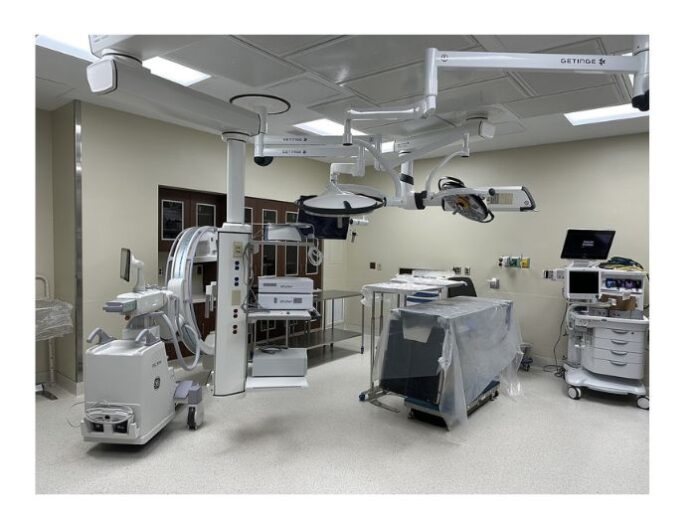By David Slone
Times-Union
WARSAW — When Parkview opens as Parkview Kosciusko Hospital on Jan. 9, it’ll be extending its care to offer services like inpatient and outpatient surgical needs and a satellite location of the Parkview Packnett Family Cancer Institute.
While an open house is scheduled for the public Saturday from 11 a.m. to 3 p.m., media were given an early peak at the new facilities at 1355 Mariners Drive, Warsaw, on Thursday.
“I’m really proud of what we built and I’m glad you’re here to see it,” said Jeffrey Rockett, vice president of operations for Parkview.
“This is kind of our first satellite location and bringing services to the community so we’re extremely excited,” said Megan Smith, chief operating officer of the Parkview Packnett Family Cancer Institute (PPFCI).
In an overview of the project, Rockett said Parkview Warsaw was an 86,000-square-foot building. With the expansion project, they added 88,000 square feet – more than doubling the building’s size – and connected the two buildings through a series of forward-facing corridors.
Cancer Institute
The first-floor corridor leads into the PPFCI. There’s a large waiting area, some registration bays and a meeting room.
“We tried to design the facility to have kind of an open-flow design so that there’s a lot of natural light coming in as you move from the existing building over into the new space,” Rockett said.
An outpatient and hospital pharmacy also has been added to provide that new service. “We now have a full-service pharmacy here. We have a Coumadin clinic as well so that our pharmacists can work in the pharmacy and handle our ATU patients – our Coumadin patients – as well,” he said. “Really excited. A great benefit to the patients that are receiving services here and for the staff as well.”
There are two main components to the PPFCI, clinic and infusion spaces.
“We tried to emulate what we have in Fort Wayne. So we have exam rooms where patients will be seen by a physician or an advanced practice provider, and then they’ll go over for their treatment on the infusion side,” Smith said. “Everything is really close. Our physicians are able to monitor reactions and anything while patients are undergoing treatment.”
The exam rooms are all dual sided down the patient corridor. The staff are on one side. “It keeps the chaos of busyness of the staff away from the patient-facing areas, and really gives the patients that feeling of calmness as they’re going throughout their visit,” she said.
There’s space for physicians, advance practice providers and the nursing staff to work between going in and out of the exam rooms to take care of patients.
The infusion space was designed on patient feedback from the PPFCI in Allen County, Smith said.
“They’re all semi-private bays. All of them have a nice view from the bed to the healing garden. We do have a private room where we can do bone marrow biopsies, if a patient needs to be in a private room for isolation purposes for that day or just needs a quiet space,” she said.
A lot of the cancer process will be able to be done in Warsaw instead of a patient driving an hour to Fort Wayne.
“For certain things, they’ll still have to go to Allen County. For big surgeries that they need an ICU for, that needs to be in Allen County. Some of our research studies, just the way they’re set up. We initially won’t start with research here, it’s just a lot of infrastructure to build, and so that will remain in Allen County. But for all of our routine chemotherapies, they can do everything here that we can do in Allen County,” Smith explained.
The goal is to keep patients home.
Smith said Parkview has about 4,000 analytical cancer cases, which means new diagnosis or if they rediagnose. “So we see about 4,000 new cancers a year, throughout the health system.” That includes cancer of the colon, breasts, lung, lymphomas and leukemias.
“We’re very fortunate we have an orthopedic oncologist, which the only other ones are in Indianapolis, so we’re lucky to have him. That’s a very rare cancer that most healthcare organizations have to send out, and we don’t,” she said, adding that they don’t send too many cancer patients out to other healthcare providers.
Inpatient Unit
The third floor is all inpatient services.
“We built out 28 rooms. We equipped 24 of them for opening. We will open up our beds in a staggard fashion, so we will open up in January with 12, and then continue to open up more beds as patient volume exists and demands and we have new staff,” said Rockett.
Whether a person is receiving inpatient or outpatient care, Scott Gabriel, Parkview Health Northwest market president, said, “There’s no difference in the care. So the staff doesn’t know the difference between an inpatient and an observation patient. Many of them can be here for a couple days, so they are all in the same room treated exactly the same. It’s really on the backend, more of a billing process, than it is anything delineated how patients are cared for.”
The rooms are set up in a large circular track formation so all 28 rooms are in the same unit. They are all single, private rooms with private bathrooms.
“One of the focuses we put was on patient safety when it comes to care. So all of our rooms have the same side of care. So when you go in to them, the headwall is always on the left, meaning that the care to the patient is always occurring on the right-hand side of the patient. Families are always on the left-hand side of the patient. That’s really important to us. It helps with standardizing processes. It helps eliminate errors, and the patient always knows that care is given on one side,” Rockett explained.
Each room also has a window looking over the healing garden or the wooded area. There’s lots of sunlight coming into the rooms. The headwall is the same headwall in all 28 rooms and happens to be one of the art submissions by someone in the county. In fact, all the artwork in the building were either submitted by local artists and photographers or the image is from the Kosciusko County.
The main reason they’re staggering the rooms in segments is to make sure they have the staff appropriately trained to care for the patients.
“There’s a shortage of nurses around. We didn’t want to bring in traveling nurses or other folks to do this. We really wanted to bring in Parkview-oriented nurses who have been trained appropriately, so we started with 12. As we hire the next batch of staff, we can train them while the first 12 are opening up and then we’ll open up the next batch until we get to the full 28,” Gabriel explained.
“One of the things we did learn when we designed this – and we paused for a period of time due to COVID – and that really shifted the design of this unit. So, we made the unit larger, understanding many hospitals – almost all hospitals – were really needing more beds and they were also in need of rooms that could care for patients that needed isolation. So we were able to design that into this build, so in this unit we have nine rooms that can be converted to what we call a negative air flow, so if somebody has something like COVID, we need to protect everyone else around and keep them in an isolated room, and that’s something really important,” Rockett said.
Of the 28 rooms, he said 24 are designated as medical/surgical, which is the standard inpatient room. Four of them have been designed to be a little larger and are called progressive rooms, which is a step up from a routine medical/surgical room but a step down from an ICU room.
“We don’t have ICU rooms here in this community hospital, so anyone needing that level of care … we would move those patients to Allen County to our tertiary hospital to get that care, but we can certainly take care of them up to the point where they need that ICU-level care,” Rockett said.
The progressive rooms are deeper and wider to accommodate the additional equipment that may be needed. There’s also a window in the hallway looking into the room “because in this area, the patient-to-nurse ratio is lower where we strive in our medical/surgical area for four patients to one nurse. Here, it’s typically a two-patient-to-one-nurse model because of the higher level of care needed, and that extra window provides some additional visualization of the patient,” Rockett said.
Surgical Services
On the second floor of the new building is surgical services.
“Our surgery unit includes our pre-op, post-op and post-anesthesia unit. Those are the bays, or the beds, that you would come into when you first get here for surgery and then recover in after surgery. We will open up on Jan. 9 with two ORs (operating rooms) and two procedure rooms. And then in our design, we built out and shelled out two additional spaces for two more ORs, so we have the ability to grow up to four surgical suites, or ORs, and then we have two procedure rooms. We could also build out one of the future ORs into two more procedure rooms, if needed there,” Rockett said.
The operating rooms were designed to handle any routine general orthopedic surgery here in the community. There are some surgeries that require a higher level of care that they will automatically take to a higher level, such as cardiac surgery.
Gabriel said, “The majority of surgeries we do in our community hospitals are outpatient surgeries, so most of them come in, have their surgery and go home. Very few of them are admitted.”
The second floor also will have 19 pre- and post-PACU (post-anesthesia care unit) bays. They wrap around the two sides of the unit.
There’s a nurses station for the pre-op side, and smaller rooms for patients that have procedures that don’t require general anesthesia. There’s a scope washing/processing room between the two procedure rooms.
ORs 3 and 4 are for future growth. There’s a control center for OR where the supervisor will be to make sure everyone’s working on time and the right procedure is going on in the right room.
OR 2 is a lot larger with a lot more equipment than the procedure rooms. Gabriel said they will have one full-time surgeon, but he’s part of a group so they will be rotating in. Gabriel said they believe they have a letter of intent with a second surgeon for general surgery.
They also will have some OB/GYNs doing some cases.
“So a lot of folks who come from Fort Wayne who have clinics here may elect to do a day or so, a half of day, of surgery here, but they won’t do the full-time practices here,” he said.
Rockett said they designed an OR space not knowing what type of surgeries they would do and who their surgeons would be.
“And I think we designed a really functional OR that will be a great starting platform with the two shell spaces to add more OR space going forward. We’re in really good position to serve the entire Kosciusko County,” he stated.





